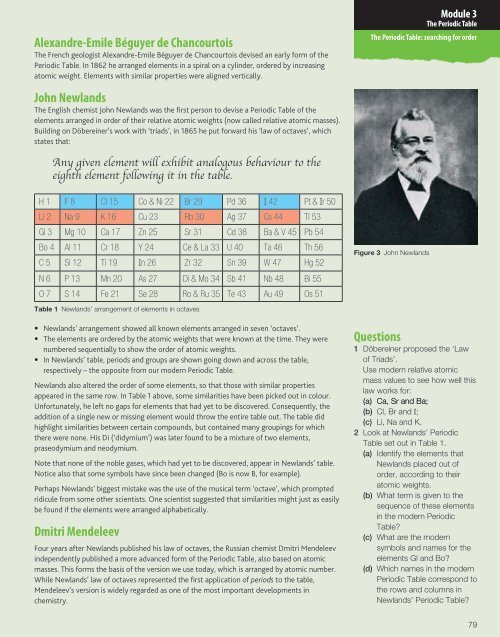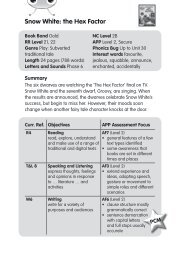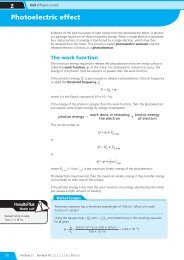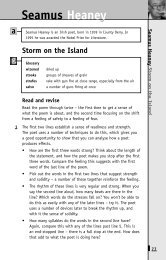Unit 1 Module 3 The Periodic Table - Pearson Schools
Unit 1 Module 3 The Periodic Table - Pearson Schools
Unit 1 Module 3 The Periodic Table - Pearson Schools
You also want an ePaper? Increase the reach of your titles
YUMPU automatically turns print PDFs into web optimized ePapers that Google loves.
Alexandre-Emile Béguyer de Chancourtois<br />
<strong>The</strong> French geologist Alexandre-Emile Béguyer de Chancourtois devised an early form of the<br />
<strong>Periodic</strong> <strong>Table</strong>. In 1862 he arranged elements in a spiral on a cylinder, ordered by increasing<br />
atomic weight. Elements with similar properties were aligned vertically.<br />
John Newlands<br />
<strong>The</strong> English chemist John Newlands was the first person to devise a <strong>Periodic</strong> <strong>Table</strong> of the<br />
elements arranged in order of their relative atomic weights (now called relative atomic masses).<br />
Building on Döbereiner’s work with ‘triads’, in 1865 he put forward his ‘law of octaves’, which<br />
states that:<br />
<strong>Module</strong> 3<br />
<strong>The</strong> <strong>Periodic</strong> <strong>Table</strong><br />
<strong>The</strong> <strong>Periodic</strong> <strong>Table</strong>: searching for order<br />
Any given element will exhibit analogous behaviour to the<br />
eighth element following it in the table.<br />
H 1 F 8 Cl 15 Co & Ni 22 Br 29 Pd 36 I 42 Pt & Ir 50<br />
Li 2 Na 9 K 16 Cu 23 Rb 30 Ag 37 Cs 44 Tl 53<br />
Gl 3 Mg 10 Ca 17 Zn 25 Sr 31 Cd 38 Ba & V 45 Pb 54<br />
Bo 4 Al 11 Cr 18 Y 24 Ce & La 33 U 40 Ta 46 Th 56<br />
C 5 Si 12 Ti 19 In 26 Zr 32 Sn 39 W 47 Hg 52<br />
N 6 P 13 Mn 20 As 27 Di & Mo 34 Sb 41 Nb 48 Bi 55<br />
O 7 S 14 Fe 21 Se 28 Ro & Ru 35 Te 43 Au 49 Os 51<br />
Figure 3 John Newlands<br />
<strong>Table</strong> 1 Newlands’ arrangement of elements in octaves<br />
• Newlands’ arrangement showed all known elements arranged in seven ‘octaves’.<br />
• <strong>The</strong> elements are ordered by the atomic weights that were known at the time. <strong>The</strong>y were<br />
numbered sequentially to show the order of atomic weights.<br />
• In Newlands’ table, periods and groups are shown going down and across the table,<br />
respectively – the opposite from our modern <strong>Periodic</strong> <strong>Table</strong>.<br />
Newlands also altered the order of some elements, so that those with similar properties<br />
appeared in the same row. In <strong>Table</strong> 1 above, some similarities have been picked out in colour.<br />
Unfortunately, he left no gaps for elements that had yet to be discovered. Consequently, the<br />
addition of a single new or missing element would throw the entire table out. <strong>The</strong> table did<br />
highlight similarities between certain compounds, but contained many groupings for which<br />
there were none. His Di (‘didymium’) was later found to be a mixture of two elements,<br />
praseodymium and neodymium.<br />
Note that none of the noble gases, which had yet to be discovered, appear in Newlands’ table.<br />
Notice also that some symbols have since been changed (Bo is now B, for example).<br />
Perhaps Newlands’ biggest mistake was the use of the musical term ‘octave’, which prompted<br />
ridicule from some other scientists. One scientist suggested that similarities might just as easily<br />
be found if the elements were arranged alphabetically.<br />
Dmitri Mendeleev<br />
Four years after Newlands published his law of octaves, the Russian chemist Dmitri Mendeleev<br />
independently published a more advanced form of the <strong>Periodic</strong> <strong>Table</strong>, also based on atomic<br />
masses. This forms the basis of the version we use today, which is arranged by atomic number.<br />
While Newlands’ law of octaves represented the first application of periods to the table,<br />
Mendeleev’s version is widely regarded as one of the most important developments in<br />
chemistry.<br />
Questions<br />
1 Döbereiner proposed the ‘Law<br />
of Triads’.<br />
Use modern relative atomic<br />
mass values to see how well this<br />
law works for:<br />
(a) Ca, r Sr and Ba Ba;<br />
(b) Cl, Br and I;<br />
(c) Li, Na and K.<br />
2 Look at Newlands’ <strong>Periodic</strong><br />
<strong>Table</strong> set out in <strong>Table</strong> 1.<br />
(a) Identify the elements that<br />
Newlands placed out of<br />
order, according to their<br />
atomic weights.<br />
(b) What term is given to the<br />
sequence of these elements<br />
in the modern <strong>Periodic</strong><br />
<strong>Table</strong>?<br />
(c) What are the modern<br />
symbols and names for the<br />
elements Gl and Bo?<br />
(d) Which names in the modern<br />
<strong>Periodic</strong> <strong>Table</strong> correspond to<br />
the rows and columns in<br />
Newlands’ <strong>Periodic</strong> <strong>Table</strong>?<br />
79<br />
935 chemistry.U1 M3.indd 79 13/11/07 11:48:53 am
















